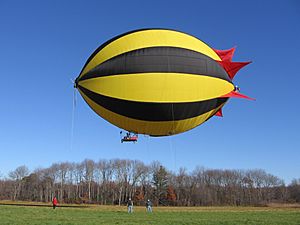Thermal airship facts for kids
A thermal airship is a special type of airship that gets its lift by heating the air inside a huge bag called an envelope. Think of it like a giant hot air balloon that can steer itself! The hot air inside is lighter than the cooler air outside. This difference in weight makes the airship float upwards.
Unlike a regular hot air balloon, which just drifts with the wind, a thermal airship has engines and propellers. This means it can move where it wants to go. Some thermal airships might even use steam to create lift!
Other kinds of airships use gases like helium to float. These gases are naturally lighter than air even when they are not heated.
Contents
Why Thermal Airships Are Cool (and Their Challenges)
Thermal airships have some great benefits, but also a few challenges.
Benefits of Thermal Airships
- Less Expensive: They usually cost much less to build and operate than airships that use helium.
- Easy to Store: After a flight, they can be deflated. This makes them easy to pack up, store, or move to a new location. This is why they are often called blimps, which are non-rigid airships.
Challenges of Thermal Airships
- Less Lift: Hot air doesn't lift as much weight as gases like helium or hydrogen. This means thermal airships need to be built very lightly.
- Slower Speeds: Because they are built lighter and have less lift, they usually fly at lower airspeeds.
- Tricky to Handle: It can be hard to control them on the ground if the wind is blowing too much (above 5 knots).
- Steering Can Be Hard: Steering can be difficult, especially when flying slowly.
- Bumpy Ride: Sometimes, the airship might bob up and down (like a dolphin, which is called 'porpoising') when the pilot changes the engine speed. This is because it's harder to control the up-and-down movement.
Luckily, engineers have found ways to make steering better. One way is to put more air pressure in the tail fins. Another is to use a special inner structure to help keep the airship's shape.
A Brief History of Thermal Airships
The very first time a hot air airship flew in public was in January 1973. A man named Don Cameron from the UK flew his Cameron D-96 airship. It took him three years to design and build it!
How Thermal Airships Are Built
Most thermal airships are non-rigid, meaning they don't have a hard frame inside. Their shape comes from the air pressure inside.
Sometimes, air is pushed into the envelope by a fan. Other times, the air pressure comes from a special duct behind the propeller.
In 2006, a company called Skyacht Aircraft created a new design. Their airship has an unpressurized envelope. Instead, it uses a frame made of aluminium ribs inside to hold its shape. This frame can fold up like an umbrella when the airship isn't being used! This design also allows the engine and propeller to be mounted on the tail. This helps with steering, making the airship able to make tight turns.
How Thermal Airships Fly
Just like hot air balloons, thermal airships start by being filled partly with cold air from outside. Once the envelope is big enough, a propane burner is lit. This burner heats the air inside, making the airship fully inflate and ready for flight!
See also



